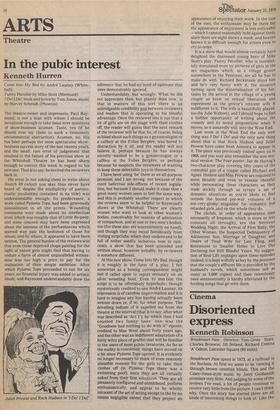Cinema
Disoriented express
Kenneth Robinson
Breakheart Pass Director: Tom Gries Stars: Charles Bronson, Jill Ireland, Richard Crenna 'A' Odeon, Leicester Square (95 mins).
Breakheart Pass opens in 1873, at a railroad in the Rockies. At first we seem to be viewing it through brown venetian blinds. This and the Casey-Jones-style music by Jerry Goldsmith promises very little. And judging by some of the reviews I've read, a lot of people continue to receive very little from the picture. I can't think why. Once the story has started there are all kinds of interesting things to look at. Like the
man who wears a knife between his teeth while he takes a stroll on the carriage roof-tops. And the elegant hand-painted motifs on the engine's tender.
It's all a bit of a muddle at the beginning, While we sort out why the train has stopped at a wayside halt. But at least the brown
venetian-blinds have gone by then, not to return until the closing credits. In between we
have ninety-five minutes of murders on the
disorientated express. The inevitable detective is portrayed by Charles Bronson, looking like a
battered Poirot. Everybody thinks he is a notorious outlaw. As it happens, he is the only hbnest civilian on board, apart from a rather nice girl played by Jill Ireland. You can tell how nice she is because she refuses to be kissed on her bunk by the governor of Nevada. He must wait, she says, until they get off the train. Earlier in the picture eighty-four men are killed simultaneously. This happens when their trot),
p carriages are severed from the rest of the train and topple backwards off the line. The Whole thing is exquisitely done.
Because this is an 'A'-certificate film, we see no bodies falling from the crumpled carriages. Nor does the discreet director give us so much as a sawn-off foot lying in a snow-drift. The fact is that this film is the best example to date of the beW-style Family Violence picture. It had to come and I think we can look forward to more of its kind. All the careful views of men falling off bridges, or collapsing with funny red bullet-marks on their foreheads, are in tasteful contrast to the lush interiors of the train. Every time we are taken outside to see a couple fighting to the death on a carriage roof, evoking inappropriate memories of George Formby or Will Hay, we know we shall soon be back in the warm colours of the train's drawing-room. And I. realised in these scenes what an advantage the cinema has over the theatre. It is so nice to be watching a drawing-room thriller while Magnificent scenery teeters by outside the window.
I cannot begin to explain why Charles Bronson happens to have several sticks of dynamite ready for some spectacular train exPlosions in the finale. Nor can I imagine how he expected to avoid blowing up Jill Ireland in her compartment. She would have been safer in tile original book, by Alistair MacLean, because the couple were galloping off on horseback . When the train exploded. In fact the book finishes with the train falling off a viaduct with the engine on top of it. I imagine the film Company had already spent too much for such an extravagant ending. aut they could at least have allowed the couple to smile at each, other, as they do on the last page of the novel, and to decide that it doesn't have to be such a long, hard winter after all.
The director spoils all this. He lets the girl embrace her father, while Charles Bronson walks off in solitude, like all those knight-er_rants of fiction from the Saint to James Bond.
You might think by the way Mr Bronson was Walking that he was in some sort of trouble. If so it means you haven't seen him before. He has a habit of wearing clothes about three sizes too slball. So be not only walks with apparent difficulty but also comes to a standstill looking 'Ike something waiting to be melted down at ,Madame Tussauds. As usual he is obviously longing to get away from the film-set and to Climb into something loose and comfortable.
„, 'Why', somebody asks near the end of the
jma , 'are the Indians so cross?' I can only guess. S it because whenever they appear they are given an electronic fanfare on a Moog SYnthesiser?



























 Previous page
Previous page